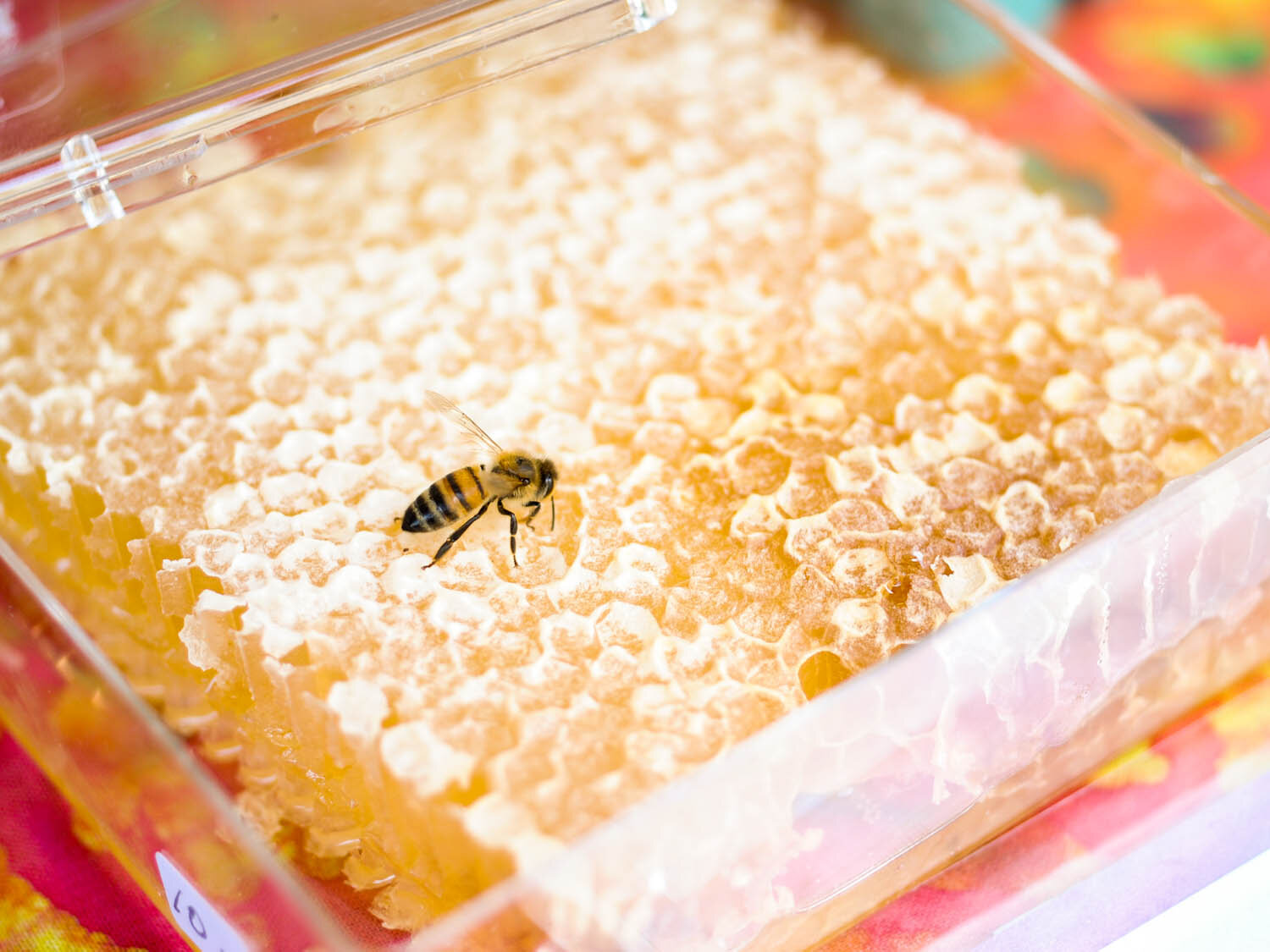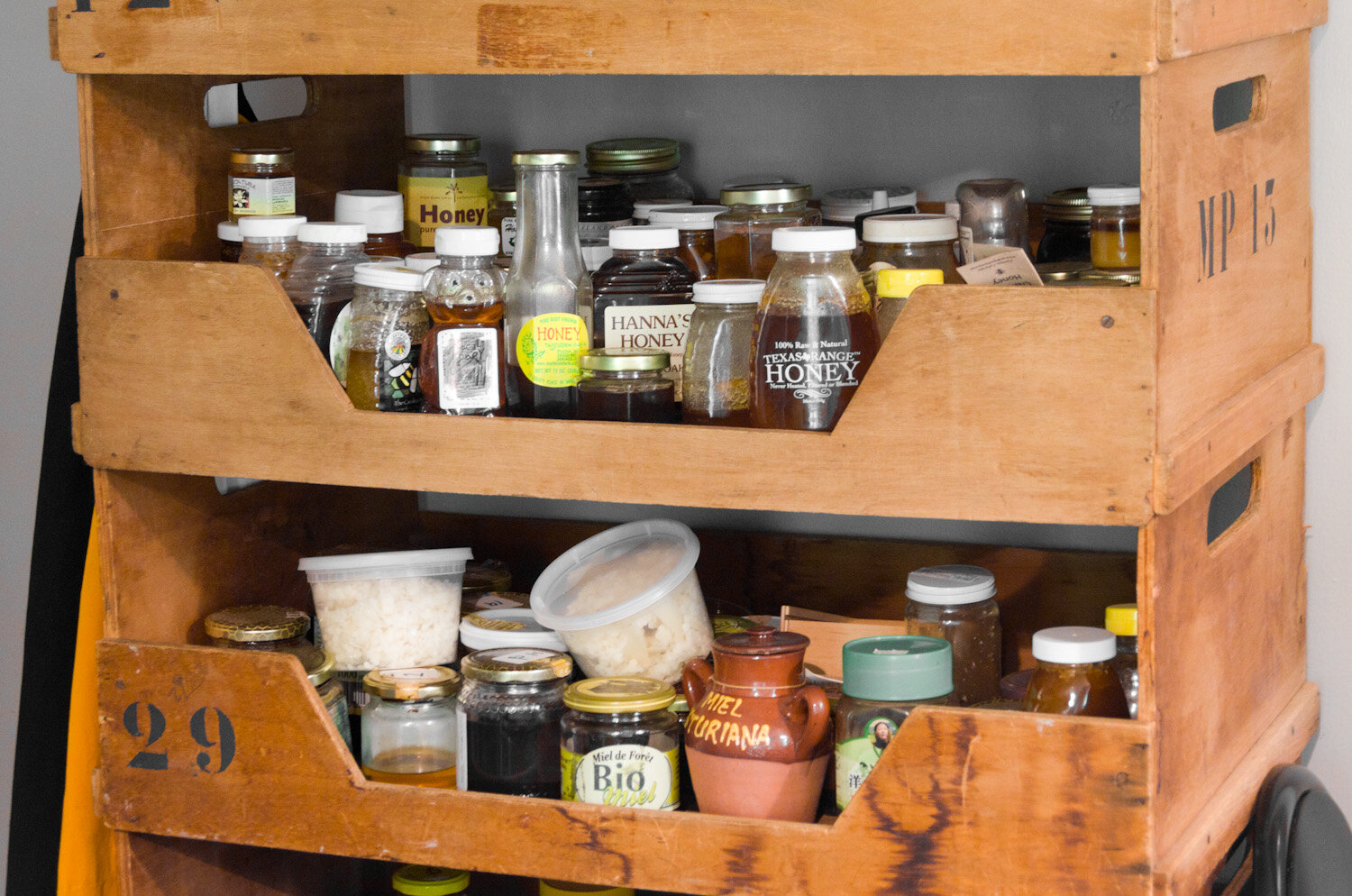How to Taste (and Fall in Love With) Raw Honey
Image: Bottles of honey in various colors with the Red Bee label line a windowsill. Photo by Max Falkowitz.
by Jacqueline Raposo for Serious Eats
Originally published March 2, 2015 — Last Updated: August 10, 2018
Good raw honey is practically a different product from the "Grade A Amber" plastic bears that line supermarket shelves. The latter is accumulated from thousands of colonies, then boiled down until all its dynamic flavors are distilled to one word: sweet. But the raw stuff, harvested at peak season and bottled without a lick of heat? That honey is liquid gold.
Bursting with caramel or butterscotch; fragrant with citrus, minerals, or the intoxicating aromas peonies and jasmine; jammy with berries and currants and dried fruit—that's the kind of honey worth relishing. The kind worth slathering on toasted rye bread smeared with goat cheese. The kind with acidity as well as sweetness, to bring extra depth to your hot toddy. Good honey is just as layered and complex as wine, chocolate, and olive oil, and just as deserving of our appreciation.
You've seen what it takes for a colony of bees to make honey, and the work beekeepers put into helping their colonies thrive. Now what goes into tasting the stuff and getting the most out of your raw honey? A bit of know-how will take you far.
Image: Books about making honey by C. Marina Marchese. Photo by Max Falkowitz.
The Geography of Honey
Raw honey is a regional product; American beekeepers have actually drawn up seven or eight (depending on how you count them) distinct apicultural regions of the U.S. Where your honey's from, and what flowers went into it, have big impacts on its flavor and texture.
Part of that regionalism is the plants that a colony draws nectar from, and that information is usually right on the label. An zesty orange blossom honey won't taste like a grassy alfalfa or dark, tangy buckwheat, and even wildflower honeys can taste wildly distinct. Many beekeepers use the blanket term "wildflower" for a honey fueled by different kinds of flowers, but what "wildflower" means varies by region. New England teems with clover, berries, goldenrod and sumac; the western Rocky Mountains have cactus, yucca, agave, alfalfa, and mesquite. So a New England and a Western wildflower honey will have noteworthy differences.
Image: Wooden shelves packed with various jars and bottles of honey. Photo by Max Falkowitz.
Changing seasons also affect a honey's taste, texture, and color. A plant only has so much sugar to disperse to its blossoms. In spring, when those blossoms are just bursting, the resulting honey tastes less sweet. Later on in the season, when plants are competing like mad for pollinating bees to pay them a visit, they compound more sugar and nutrients into fewer flowers, producing darker, more full-bodied honeys, like the late-season buckwheat and goldenrod.
There are obviously exceptions to that rule, but if you compare spring, summer, and autumn honeys from a single producer, it's easy to see the differences in color alone, from light yellow to deep orange and rusty brown.
Southern beekeepers are lucky; their climate is warm enough for bees to collect nectar nearly year-round (unlike the Northeast and Northwest, which have far shorter growing seasons), so even one region can produce wildly different "wildflower" honeys in a given year. Take a look at these honeys from Eden's Nectar in the photo above. Their spring honey is incredibly light, fruity, and fragrant thanks to the blooms of citrus trees. Skip a few months over to winter and you'll find deep molasses notes, round currant flavors, a thicker viscosity, and a dark brown hue.
Seasons and weather changes impact bees' honey production as well. A strong growing season can affect a honey's flavor, and uncharacteristically wet or dry air impacts a honey's water content. But if you're just dipping into raw honey, you can come back to those distinctions later.
Image: A tray of a hive teeming with bees. Photo by Max Falkowitz.
Honey Flavor Profiles
Ask yourself what honey tastes like, and chances are "sweet" is, indeed, what pops first to mind. Commercial honey is blended, boiled and reduced to hit a median of what we assume honey should look and taste like, with a general sweetness being the most prominent thing on the tongue. But when it comes to raw, small-batch honey, sweet is just the beginning.
The term "terroir" applies as much to honey as wine, chocolate, and olive oil—earth and air have profound effects on its flavor. Here are some common flavors to help build your honey-tasting vocabulary:
Floral: Flowers like violet, rose, peony, honeysuckle and jasmine.
Fruity: Tropical fruits like pineapples and mango; berries; citrus (is that a lemon, lime or grapefruit?); and dried fruits like raisins, prunes and apricots. Beyond that, are those fruits ripe and sweet or unripe, like green figs or bananas?
Warm: Burnt sugars like caramel, marshmallow, and butterscotch; creamy notes of yogurt or butter; deep flavors of vanilla and chocolate.
Fresh: Crisp flavors like citrus and herbs like thyme and mint.
Vegetal: Fresh plants, raw vegetables, wet grass, hay and straw.
Animal: Sweat, manure, leather.
Woody: Cedar, oak, pine, cinnamon, clove, nutmeg.
Chemical: Plastic, soap, metal, tar, ash.
Funk: Yeast, fermentation, must, moss, mold (think ciders, bread, mushrooms, and truffles).
Not all honeys are that complex; some are simply light and sweet, maybe with some gentle floral or fruity accents. But others have layers of flavor that develop, some prominent on the nose, more developing as the honey hits the palate, and others lingering in a long finish. And those layers are where geography and weather come into play.
How to Host a Honey Tasting
The best way to start learning distinctions between different kinds of honey is, of course, to eat a lot of it, and to do so with side-by-side comparisons. When setting up a honey tasting party, there's hardly a better guide than Marina Marchese. Along with horticulturist Kim Flottum, Marchese outlines how to set up a tasting party and consider the results in her latest book, The Honey Connoisseur. Here's what they suggest:
Set the Stage
Image:Wine glasses of honey in varying colors. Photo by Max Falkowitz.
Image: Jars of honey with bread and whipped cheese. Photo by Max Falkowitz.
Set The Stage
If you're relatively new to the honey-tasting game, pick a few varieties from different flower sources, seasons, or regions so you can best compare and contrast most dramatically. Later on you can try different honeys from the same flower source (wildflower, clover, and bassweed are common) and compare their similarities and differences.
For Honey 101, put each sample into labeled transparent plastic or glass containers so you can notice the differences in color and viscosity. At a graduate student level? Try a blind taste test and see how the honey tastes without labels or color clues.
Set out a spoon for each sample available, so you can stir and notice textures and viscosity.
Make sure each guest has room temperature water for palate-cleansing, something to take notes with, and aroma and flavor guides like Marchese's Aroma and Tasting Wheel for reference.
Serve apple slices, bread, and a variety of cheeses and nuts so you can see how the honeys pair best with food.
Image: A spoon of light-colored honey coming out of a wine glass. Photo by Max Falkowitz.
Image: A spoon of dark, thick honey coming out of a wine glass. Photo by Max Falkowitz.
First, look at the color. Is it white, a light or pale amber, or a shade of brown? What preconceptions does that give you about the flavor? While we assume that lighter honeys are going to be simpler and lighter in taste and darker honeys will be round and rich, this is not always the case. Want to test your preconceptions? Try tasting blindfolded and see if your guesses on flavor intensity match up with color.
A honey's appearance is about more than color. Is it opaque or dense? Is there one hue throughout it or variations within? "Good honey is rarely 100% transparent," Marchese notes, citing the remnants of pollen and wax or inevitable airborne dust from hand-bottled jars that can make their way into honey.
Now stir the honey with a spoon and notice how thick or thin it is. Most honey isn't taken from the hive until bees have sealed it with a wax cap, knowing they've fanned it down to 16 to 18% moisture. But the time of year it was bottled or concentration of sugars (again, from which season the honey came from) can subtly yet noticeably affect the texture. Is it easy to drizzle, or has it started to thicken or crystalize? If so, are the granules small or large?
Next, smell it. Honey's perfume can be intoxicating, with layers of fruit, flower, air, and earth. Take a huge whiff close to the spoon and note what you smell. Move the spoon away and sniff again; how potent is the aroma now? Some honeys are extremely mild in aroma, whereas others are excitingly potent.
Finally, taste it. Go beyond sweet. Really good honeys have flavors that unfold once our palates adjust to the sugar. Look at the tasting wheel: If it's acid you're getting, is that from a citrus note of orange, grapefruit, or lemon, or the almost fermented tang of vinegar? Does that tropical flavor make you think of ripe or green bananas? Does the flavor sit on your tongue and quickly pass, or do you notice more and more as it hits different parts of your mouth and your throat? Jot down the general thoughts that come and then anything specific—is that burnt sugar taste a caramel or a butterscotch?
Pay attention to the texture, how the honey loosens up in your mouth. And if you're tasting comb or chunk honey—honey left in its waxy honeycomb—how does it feel when the honey spurts out of its cells?
Now try matching those flavors with one of the foodstuffs around you. How does a light, floral honey go with a funky cheese or a bit of dark chocolate? Does a deep, rich honey work well with just a chunk of baguette? Do you want to pair light with light and dark with dark, or contrast flavors?
Image: A shelf of jars of Red Bee honey. Photo by Max Falkowitz.
Image: A jar of organic Oaxacan honey. Photo by Max Falkowitz.
Some Honeys to Seek Out
As soon as you start noticing how many kinds of interesting honeys are out there, it's hard to stop collecting them. The easiest way to start building a honey collection is to try what's local to you. In the spring and summer months, an abundance of honey can be found at farmers markets nationwide. Here are some of our favorites that you can find at specialty stores and online.
Wild Blueberry Honey: If you're going to go for a straight-up American fruit honey, you can't really go wrong with blueberry honey from Maine. Michigan, Oregon, New Jersey, California, Florida and Georgia all grow massive crops of blueberries, but the wild blueberries of Maine help bees make a honey so pungent with fruit flavor you could almost call it jam. It has a smooth texture and notes of deep violet and jasmine flowers as well. Swirl it in plain yogurt sprinkled with a little mint, drizzle it over any mild cheese, or smear it on top of fruit muffins.
Chestnut Honey: If you've ever smelled freshly roasted chestnuts, try to imagine their woody, rich, smoky flavors encapsulated in a honey. Chestnut honey is almost as adored in Italy as Champagne is in France, and its amazingly concentrated flavor is, as Gina DePalma puts it, "not for the timid palate." The honey delivers a funk that's equally at home with pungent Pecorino and gorgonzola or sweetening black tea.
Buckwheat Honey: Buckwheat grows all over the world in moist, cool environments, and its beautiful white flowers blossom until temperatures drop to freezing, meaning that bees can harvest nectar deep into fall. It's hard not to notice buckwheat honey on a lineup—the almost black color and thick, sticky consistency defy our preconceived notions about what honey should look like. The taste is incredibly dark as well, reminiscent of musky basements and wet earth. Layered amidst the musk are nutty notes of chocolate, dark cherries, and sweet toffee that pair well with rich, dark desserts. With an earthiness similar to maple syrup, it's also delicious on pancakes and waffles, paired with whipped cream or a tangy goat yogurt.
Guajillo Honey: The guajillo chili plant grows in the dry limestone hillsides of the American southwest and Mexico, and it produces sweetly scented white flowers in abundance. The amber/orange honey is full of jammy fruit flavors like peach, apricot, and mango, and it has a long finish with a slightly metallic note. It pairs well with food from the Southwest, such as stone-ground corn in tortillas and pancakes; it sings in glazed pork dishes.
Wild African Honey: Okay, the following is somewhat controversial, and we offer it up purely for an "if it's offered to you, take note" scenario. African bees are far more violent than their Italian honeybee cousins, and harvesting their honey can mean they'll chase after and sting you for a kilometer. African bees often make their hives in hollowed-out trunks of wood or small caves, and to extract the honey, harvesters smoke them extensively, killing most of the bees in the process. The resulting honey is therefore incredibly dark and smoky, with a color akin to motor oil and a musky linger. It's a pungent, acquired taste, one that challenges and broadens the palate. Fortunately, organizations like the African Bronze Honey Company are working to harvest African honey safely and sustainably, benefitting bees and beekeepers alike.
More Honey Reading
The following resources are only a drop in the bucket with how far honey exploration can take us. To explore more, check out a few of the many wonderful beekeepers and educators below, or start playing with some of our favorite honey-sweetened recipes.











